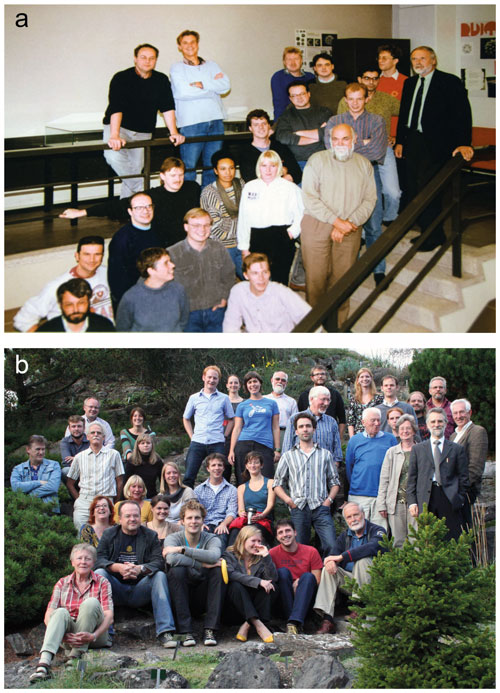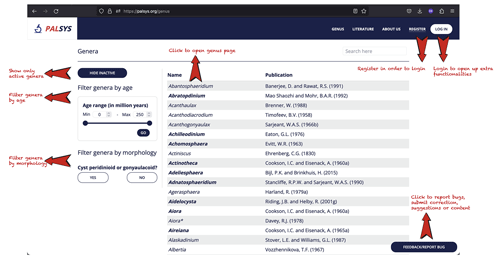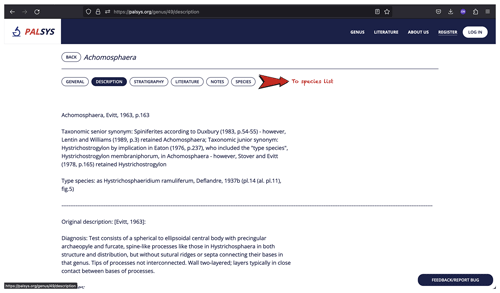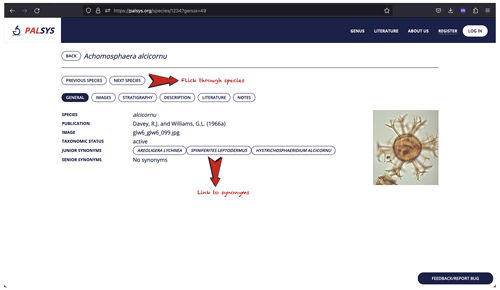the Creative Commons Attribution 4.0 License.
the Creative Commons Attribution 4.0 License.
Palsys.org: an open-access taxonomic and stratigraphic database of organic-walled dinoflagellate cysts
Henk Brinkhuis
It is with great pleasure that we introduce palsys.org (https://palsys.org/genus/, last access: 8 December 2023), a fully open-access taxonomic, stratigraphic and image database of organic-walled dinoflagellate cysts. Palsys.org started as the in-house database of the Laboratory of Palaeobotany and Palynology (LPP) Foundation over 30 years ago. It is now owned by Utrecht University and has been expanded and transformed into a public online platform for use in research and education. Palsys.org includes the taxonomic descriptions of genera and species of organic walled dinoflagellate cysts, from the (often translated) literature, and emendations and synonymy, mainly following Williams et al. (2017) and the stratigraphic calibrations from DINOSTRAT (Bijl, 2022), and has around 25 000 images of species. Here, in this launch paper, we explain the history of the database, present its current functionalities and explain our set-up of the data quality control. We call upon the community to help us keep palsys.org up to date and complete by, for example, by sending additional information, imagery and feedback in general through the platform. Palsys.org brings dinoflagellate micropaleontology in line with the open-science principles of modern academia.
- Article
(3237 KB) - Full-text XML
- BibTeX
- EndNote
Palsys.org (https://palsys.org/genus/, last access: 8 December 2023) started in the 1990s as a Microsoft Access database template called PALSYS at an Utrecht University (UU)-embedded geo-consultancy, the Laboratory of Palaeobotany and Palynology (LPP) Foundation. It was designed to host taxonomic, stratigraphic and image data of micropaleontological species and was supported by significant grants from industry. The primary source of its content has always been the peer-reviewed scientific literature. Many international colleagues contributed willingly and generously to the ever-growing image database with copyright-free content (see the “Acknowledgements” at the end of the paper). This, together with the UU and LPP databases, now results in > 25 000 images captured by mid-2023.
Initially, PALSYS served mostly to build basin- or project-specific catalogues of organic-walled dinoflagellate cysts for commercial partners. Revenue from this project enabled the LPP Foundation to expand the in-house databases. The key initiators in those days were Jan-Willem Weegink and Henk Brinkhuis. In the late 1990s, many students helped translate non-English taxa descriptions into English and gathered and uploaded images, as a side-job. Further functionality improvements and database additions were later made by the biostratigraphy team at the Netherlands Institute for Applied Scientific Research (TNO), which took over the commercial activities of the LPP Foundation in 2000. In that decade, the efforts by Jan-Willem Weegink, Oscar Abbink and Timme Donders in particular were instrumental. In the following decade, the research group at the LPP expanded, eventually with new permanent staff members, Appy Sluijs and Francesca Sangiorgi, and a new chair in marine palynology and palaeoecology, Henk Brinkhuis (Fig. 1b).

Figure 1The Laboratory of Palaeobotany and Palynology (a) in 1992. From top to bottom and from left to right: Jan-Willem Weegink, Martin Wilpshaar, Peter Hoen, Oscar Abbink, Henk Visscher, Henk Brinkhuis, Michiel van Houte, Jordi Tarragona, Bart Derks, Jan van Tongeren, nomen nescio, Frederike Wagner-Cremer, Johan van de Burgh, Christian Mulder, Wolfram Kurschner, Andrea Santarelli, nomen nescio, Roel Verreusel and Raymond Below. The Laboratory of Palaeobotany and Palynology (b) in 2009. Jan van Tongeren, Maarten van Hardenbroek, Wolfram Kurschner, Hans van Aken, Emilia Kirilova, nomen nescio, Sander Houben, Willemijn Quaijtaal, Maud Vastbinder, Johan van de Burgh, Micha Ruhl, Zwier Smeenk, Christof Pearce, Femke Holwerda, Oliver Heiri, Thierry Fonville, Han van Konijnenburgh-van Cittert, Jos Schilder, Andy Lotter, Boris Iljashiuk, Wim Sluis, Gea Zijlstra, Marjolein Mullen, Henk Brinkhuis, Frederike Wagner, Linda van Roij, Nina Bonis, Appy Sluijs, Peter Bijl, Emmy Lammertsma, Judith Barke, Peter Spierenburg and Henk Visscher. Source for both pictures: LPP archive.
By this time, it was already clear that the MS Access platform underlying PALSYS was not sustainable for the future; modern software and security requirements dictated that PALSYS had to be transformed into an online platform. In 2012, the LPP Foundation reconvened commercial activities, and one of the first missions was to revive and upgrade the functionalities of PALSYS and to transform to the online environment. In collaboration with the applied biostratigraphers at TNO, notably Sander Houben, we created a completely new design for the platform, and the result is now palsys.org. The funding for this upgrade came from the LPP Foundation, Department of Earth Sciences and Physical Geography at Utrecht University, TNO and several institutes, who saw the ideal platform for training and education, a way to reduce storage space and a new way of housing micropaleontological data in modern academia in palsys.org. Palsys.org launched in 2016 and was licence-accessed only. The revenues of the licenses provided the means to update website functionalities and content. When the LPP Foundation was dissolved in 2018, and partly transformed into the non-commercial UU Henk Visscher Foundation, the intellectual property of palsys.org was transferred to the Department of Earth Sciences at Utrecht University. As part of the university's commitment to open science, palsys.org was prepared to become an open-access platform, the result of which is launched here.
Palsys.org is currently hosted by TransIP, with MySQL as the database system, but will be transferred to the servers of Utrecht University in the near future. The website is written in PHP (a hypertext preprocessor), with Laravel as the framework. Integrated development environments (IDEs) include PhpStorm and Forge. The administrator interface on palsys.org allows the uploading and adjusting of all database content via the front-end, and this greatly facilitates fast, easy and continuous website content control – also for administrators who do not have programming skills. Further information on website system specifications can be given upon request.
Palsys.org user functionalities are designed with the users in mind. These are expected to have a general understanding of morphological principles of dinocysts (e.g. through Evitt, 1985) but need information to identify dinocysts at genus or species level. The home page of palsys.org (Fig. 2) starts with a full list of both active and inactive (i.e. those that have been transferred) genera. These follow the citation index and synonymy Dinoflaj3 (Williams et al., 2017), although updates and additions of new species might appear on palsys.org before the updates of Dinoflaj3. This list of genera can be filtered, first of all, by removing inactive species from the list. Secondary filtering can be done by using a slider to define a minimum or maximum age range (in millions of years). We added stratigraphic age ranges to all genera. When available, this is derived from the oldest, first occurrence and youngest, last occurrence of genera in DINOSTRAT (Bijl, 2022), when not done through an approximation based on the reported ages of the species. This allows users to filter the genera in a set time interval. A third filter option of genera is based on morphology, i.e. the suprageneric classification of Fensome et al. (1993), including the adjustments thereof on DINOFLAJ3 (Williams et al., 2017) that were used to filter the genera based on a series of morphological questions that define the suprageneric taxonomy. Clicking on a genus brings the user to a home page for the genus. Here, the primary “Publication” that established the genus, “Taxonomic Status”, the Evitt complex “Group”, its “Type” species and age range in terms of the “Min age” (i.e. last occurrence) and “Max age” (i.e. first occurrence) are listed and junior and senior synonyms associated to the genus. The latter are clickable and lead the user to the page of those synonymous genera.
The genus home page gives the user options to continue to the following:
-
The formal genus “Description”, which is a free text field (Fig. 3). This includes the description of the genus and, for those available, the more systematic emendations of Stover and Evitt (1978) and other emendations when applicable. For some genera, it includes general notes which were collected over the years during workshops and the “Advanced Course on Organic-walled Dinoflagellate Cysts”, which were organized by Utrecht University and the LPP Foundation over the past 25 years. We are still working to make the descriptions of genera complete, but for ∼ 90 % of the genera, we have the description added. The missing 10 % come from the non-English literature or from books that are not available to us. Any help by users to complete this is greatly welcomed (through the feedback functionality; see below).
-
An overview of the stratigraphic range (“Stratigraphy”) of the genus, in which the first and last occurrences of all species in that genus are presented in a histogram-by-age plot (from DINOSTRAT; Bijl, 2022). These graphs are all downloadable. Also plotted is a table that presents the underlying data, also from DINOSTRAT. For more information on which studies are included in DINOSTRAT, see Bijl (2022).
-
The “Literature” tab lists all literature associated to the genus.
-
A “Notes” page, which has functionality only for those that have login credentials. Users with an account can add user-specific notes to all pages for the genus and species for their in-house use. If users wish to use this functionality, then they must register to obtain login credentials. This is free of charge.
-
A “Species” tab, which brings the user to a list of active and inactive species within that genus. Clicking on a species brings the user to the home page of the species (Fig. 4).
The species home pages follow basically the same set-up as that of the genus but have an extra “Image” tab. Palsys.org hosts about 25 000 image files of holotypes and other specimens, mostly bright-field microscope images, but also graphics interchange formats (GIFs) that run through various focus levels of specimens and scanning electron microscope images. Several species still lack images, and we gladly accept help in completing palsys.org with images (see under 4). The “Literature” tab has all cited literature on palsys.org listed with the connected genera and species. The “About us” tab describes the history of the platform, ownership and contact details, key contributors and the licence of use and reuse.
The Department of Earth Sciences of Utrecht University, Utrecht, the Netherlands, owns the intellectual property of palsys.org. This research group has a long-standing academic expertise in the taxonomy, stratigraphy and palaeoecology of organic-walled dinoflagellate cysts. Management of the website is done by the first author of this article. The peer-reviewed literature forms the starting point of the content of palsys.org. For taxonomy, the articles that present the original descriptions and emendations are used. For synonymy, palsys.org follows the citation index of Williams et al. (2017), and for stratigraphy, it presents the biostratigraphic information from DINOSTRAT (Bijl, 2022), which in turn also bases itself on peer-reviewed literature. We intentionally disabled the possibility for users to edit content on palsys.org. This gives us academic control over the content but comes at the expense of interactivity and community engagement on the platform by users (see Sect. 4 for how we solved this). To ensure institutional independence of the quality control, an advisory board will be established that consists of at least four members from at least three institutes. This committee will serve as a sounding board and will deliver solicited and unsolicited advice on updates to the content and functionality. This ensures independent academic quality control for the content on palsys.org.
Palsys.org is intentionally designed without the possibility for open and public editing of its content so that the academic quality of the data on palsys.org can be controlled. However, we do welcome an active, engaged user community, and we welcome suggestions for edits on the content or functionality of palsys.org. To enable this, we added a “Feedback/report bug” button on each page of the website that allows users to submit suggestions or content or propose corrections on the database content. This button creates an email to the operators or administrators of palsys.org, who will perform an editorial check and consider the suggestions for implementation. This functionality allows palsys.org to become a community-fed platform, while ensuring the academic quality of the data.
With Nannotax and Mikrotax covering the taxonomy and stratigraphy of calcareous nannoplankton and foraminifera and palsys.org covering that of dinoflagellate cysts, some of the most important microfossil groups now have open access to taxonomic and stratigraphic information. There are similarities in these databases, such as the connection between taxonomy and stratigraphic range for taxa and the inclusion of images in support of the taxonomic descriptions. Yet, there are also fundamental differences in the set-up, functionalities and display, and these are foremost due to the different nature of these microfossil genera. For instance, Nannotax and Mikrotax have a stronger focus on suprageneric classification. For dinoflagellate cysts, the suprageneric classification (Fensome et al., 1993) is used as filter of the full list of genera. However, a complication with dinoflagellates is that the vast majority of fossil cyst genera and also most fossil families do not have a modern counterpart, and it is uncertain to what extent diversity in cyst morphology directly reflects biologic diversity. As such, the suprageneric classification of dinoflagellate cysts is still very much in flux, with abundant uncertain assignments of fossil genera (Fensome et al., 1993). Although palsys.org does allow filtering of cyst genera based on the suprageneric classification, the database content is intentionally not fundamentally structured on it.
This paper represents the formal launch of the online database for taxonomic, stratigraphic and image data of organic-walled dinoflagellate cysts palsys.org. We consider the launch of palsys.org a starting point from which the community can actively contribute, barrier-free, to a platform that houses the collective academic understanding of taxonomy and stratigraphy of dinoflagellate cysts. The academic world is rapidly transitioning towards open science, whereby academic data are considered a community asset and should as such be available to the public. Published scientific data are of much more academic value when they are findable, accessible, interoperable and reusable (FAIR). For a long time, taxonomic descriptions were published in closed-access articles that were inaccessible to many. Taxonomic concepts were not available worldwide, which led to later emendations and merging of species' concepts. Palsys.org delivers FAIR open-access taxonomic information of dinoflagellate cysts. By actively using palsys.org, by reporting errors and mistakes and by delivering images, users can help optimize the content on palsys.org for the benefit of the community.
The code of the platform is available upon request to the corresponding author. All data on https://palsys.org are publicly available under a CC-BY-4.0 license, which requires that the source of the information (i.e., this paper) is cited.
HB was involved in the development of PALSYS since the start. PKB led the development of PALSYS towards online and open access and wrote the paper, with input from HB.
The contact author has declared that neither of the authors has any competing interests.
Publisher’s note: Copernicus Publications remains neutral with regard to jurisdictional claims made in the text, published maps, institutional affiliations, or any other geographical representation in this paper. While Copernicus Publications makes every effort to include appropriate place names, the final responsibility lies with the authors.
There are so many people to thank for their contributions to PALSYS and palsys.org in the past that an exhaustive list is not possible. The DINOFLAJ citation index of Graham Williams, Rob Fensome and Andrew McRae, which in itself exists due to a long history, serves as the backbone for the dinocyst database on palsys.org, and the sharing of their efforts is invaluable. With apologies in advance for any omission, we definitely would like to thank Raymond Below, Jonathan Bujak, Sarah Damassa, Hans Gocht, Raquel Guerstein, Martin J. Head, Karl-Heinz Kirsch, Judith Lentin, Lars Henrik Nielsen, Martin Pearce, Michael Prauss, Walter Riegel, Kasia Sliwińska, Bruce Tocher, Laurent de Verteuil, Graeme Wilson, Martin Head, Jim Riding, Jörg Pross, Francesca Sangiorgi, Poul Schiøler, Appy Sluijs and Karin Zonneveld for providing content, images, texts, discussions and feedback. At LPP and TNO, special thanks is extended to Henk Visscher, Jan-Willen Weegink, Oscar Abbink, Timme Donders, Roel Verreusel and Sander Houben. Many students helped out over the past few years, including Karin Zwiep, Pam Vervoort, Carolien van der Weijst, Keechy Akkerman, Benjamin Hoogstraten, Emma Kilcoyne and Saskia Frauenschuh. We thank Jeremy Young and an anonymous reviewer for helpful feedback on an earlier version of this work.
Funding for the development of PALSYS had been provided by the LPP Foundation from the 1990s until 2000 and from 2012 until 2019. From 2000 until 2012, TNO gave in-kind contributions to the database content of PALSYS. Several institutes 15 have contributed since 2012 to the transformation of PALSYS to palsys.org. These include the Department of Earth Sciences and Physical Geography of Utrecht University, Heidelberg University, GNS Science in Aotearoa/New Zealand, the Geological Survey of Denmark and Greenland (GEUS) and the Dutch Geological Sur20 vey. Financial contributions by the American Association of Stratigraphic Palynologists (AASP) and the Micropaleontological Society (TMS) made it possible to make palsys.org open access.
This paper was edited by Luke Mander and reviewed by Jeremy Young and one anonymous referee.
Bijl, P. K.: DINOSTRAT: A global database of the stratigraphic and paleolatitudinal distribution of Mesozoic-Cenozoic organic-walled dinoflagellate cysts, Earth Syst. Sci. Data, 14, 579–617, https://doi.org/10.5194/essd-14-579-2022, 2022.
Evitt, W. R.: Sporopollenin dinoflagellate cysts. their morphology and interpretation, Book, Whole, American Association of Stratigraphic Palynology Foundation, Austin, TX, 333 pp., ISBN13: 978-0931871009, 1985.
Fensome, R. A., Taylor, F. J. R., Norris, G., Sarjeant, W. A. S., Wharton, D. I., and Williams, G. L.: A Classification of Modern and Fossil Dinoflagellates, Micropalaeontology, Special Paper, 1993.
Stover, L. E. and Evitt, W. R.: Analyses of pre-Pleistocene ogranic-walled dinoflagellates, Stanford University Publications, Geol. Sci., 15, 300, 1978.
Williams, G. L., Fensome, R. A., and MacRae, R. A.: DINOFLAJ3, American Association of Stratigraphic Palynologists, Data Ser., 2, 2017.
- Abstract
- History of palsys.org
- Functionality of the platform
- Quality control of the data on palsys.org
- Palsys.org needs your input
- Comparison to other taxonomic open access databases
- Concluding points and future directions
- Code and data availability
- Author contributions
- Competing interests
- Disclaimer
- Acknowledgements
- Financial support
- Review statement
- References
- Abstract
- History of palsys.org
- Functionality of the platform
- Quality control of the data on palsys.org
- Palsys.org needs your input
- Comparison to other taxonomic open access databases
- Concluding points and future directions
- Code and data availability
- Author contributions
- Competing interests
- Disclaimer
- Acknowledgements
- Financial support
- Review statement
- References








